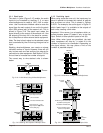
Page 13
IQ Mixer/Multiplexer Hardware Installation
Rev. 0
Crown Bus can have the same address. Suppose,
for example, an
IQ System
has two Crown Bus
loops as shown in Figure 3.1 and an
SMX-6
is
installed in loop 1 and given IQ address 77. No
other
SMX-6
can be given the same address in
Crown Bus loop 1. However, an
SMX-6
can have the
same address if it is installed in loop 2. Different IQ
components can have the same address and be in
the same Crown Bus loop. In the previous example,
an
AMB-5
could be installed in loop 1 and use IQ
address 77 because it is not an
SMX-6
.
A valid IQ address is any number from 1 to 250. Do
not use a number higher than 250 since they are
reserved for special use. An address of ÷0š (zero)
should not be used. The IQ address is determined
by adding the values of each segment of the DIP
switch which is turned on (pushed down). Figure 3.5
shows the value of each DIP switch segment. For
example, if the desired unit address is 1, only
switch 1 should be down. If the desired unit address
is 217, switches 8, 7, 5, 4, and 1 should be down
(128+64+16+8+1=217). See Appendix A for list of
all valid DIP switch settings.
If the IQ interface used is an IQ-INT, the system can
have up to eight separate Crown Bus loops. This will
enable the audio system to be divided into different
zones, each with its own Crown Bus loop. Dividing
the
IQ System
into multiple Crown Bus loops has
advantages and disadvantages which are listed be-
low:
Multiloop Advantages
• A break in communication in one loop does not
affect other loops.
• Over 250 IQ components of the same model
can be use in a system.
• The same IQ address can be used more than
once (once per loop per model).
Single Loop Advantages
• The
IQ System
can send and retrieve data
faster in a single loop.
• ÷Real timeš level display of a greater number
of units is possible.
3.2.2 Crown Bus Wiring
The Crown Bus is implemented in IQ mixer/multi-
plexers as a 20 milliamp current loop operating at
38.4 K baud so that it can function with inexpensive
twisted-pair wiring. If fiber optic wiring is required
contact Crown Tech. Support or Amcron Tech. Ser-
vices (see page 22) for information on adding the
appropriate transceivers.
Here are some guidelines for twisted-pair wiring:
• Use shielded twisted-pair wire at least 26
AWG in size. The wire should be of good qual-
ity and should NOT have high capacitance (30
picofarads/foot or less is good). Shielded wire
is recommended for situations where interfer-
ence is a problem. (West Penn 452 or an
equivalent wire works well.) The shield serves
two purposes: First, it helps prevent the IQ
data signal from transmitting to nearby audio
wiring. Second, it helps prevent outside RF
from interfering with the data signal. However,
in most cases interference is not a problem
and, since unshielded wire has lower capaci-
tance, it is a better choice.
• If shielded wire is used, connect the shield
only to the input connector.
• Add an IQ Repeater for very long
loops…greater than 1,000 feet (305 m)…or
when required by high-capacitance wire. Al-
though we recommend adding a repeater for
loops longer than 1,000 feet, it is often pos-
sible to go 2,000 feet (610 m) or more. The
most significant characteristic of the wire is its
capacitance. The lower the capacitance, the
longer the loop can be. Unshielded wire typi-
cally has less capacitance.
• Never use the ground wire in a mic snake
line.
It may sometimes be convenient to run
Crown Bus data signals to and from stage
monitor amplifiers along unused wire pairs in a
mic snake. If this is done, do not use the
ground wire which is normally connected to pin
1 on an XLR connector or data noise will be
Fig. 3.6 Crown Bus Wiring for Removable Barrier Blocks
PIN
1
2
3
4
PIN
1
2
3
4
Input (–)
Input (+)
Output (–)
Output (+)
Input (+)
Input (–)
Cable connectors are numbered as they appear from the front.
1
2
34
Mixer/Multiplexer 1
Output (–)
Output (+)
1
2
34
Mixer/Multiplexer 2
GNDGND
Optional Shield


















